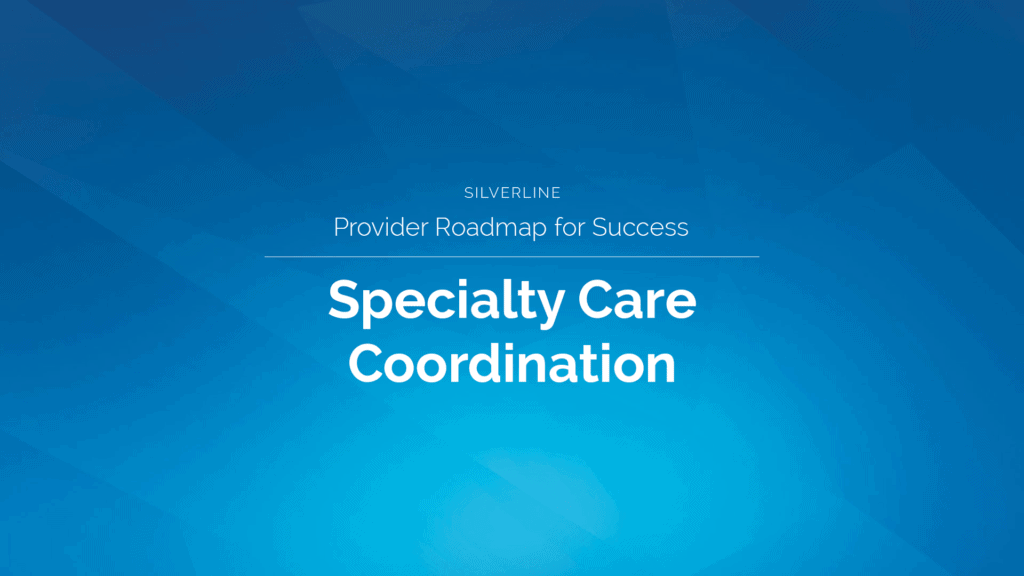This is the fifth in a series of Silverline POV’s focused on helping healthcare organizations, as providers of healthcare services to patients, be successful in five key areas as healthcare reimbursement models shift from fee for service to fee for value. Each one is focused on how to leverage the Salesforce platform and effectively navigate patients on their healthcare journey. These POV’s are based on my twenty years’ experience in healthcare and twelve years experience creating and operationalizing patient journeys utilizing Salesforce for large healthcare systems in Texas and Colorado at the physician group, clinically integrated network (CIN) and healthcare system levels.
Here are five areas we are exploring:
- Provider Relationship Management
- Consumer & Patient Engagement
- Ambulatory Care Coordination
- Transitions in Care
- Specialty Care Coordination
We will view these opportunities in the context of using Salesforce and leveraging Silverline’s suite of solutions and accelerators.
Specialty Care Coordination
Healthcare organizations tend to specialize in certain disease-specific programs or service lines:
- Oncology: MD Anderson, Memorial Sloan Kettering, Cancer Treatment Centers of America
- Cardiology & Heart Surgery: Cleveland Clinic, Mayo Clinic
- Gastroenterology & GI Surgery: Mt Sinai, Johns Hopkins
- Orthopedic Surgery: Hospital for Special Surgery (NY), Rush University Medical Center (Chicago)
However, every healthcare organization has programs or service lines that they are known for in their community and drive significant revenue into their healthcare system. They all provide disease-specific care utilizing evidence-based protocols. There are three specific programs we will discuss in detail: Oncology, Weight Loss Surgery, and Orthopedic Surgery.
Oncology
As cancer care has transitioned from an acute episode to a chronic disease, treatment has become more complex. Most healthcare organizations operate virtual cancer centers with care providers and facilities in different locations and often on different EHR’s. Nurse Navigator programs are necessary to navigate patients through prevention, screening, diagnosis treatment while accounting for a patient’s barriers to care, support system and educational needs.
Referral Management is also a key component because many of the imaging and treatment facilities are siloed and the referral decisions can be made by multiple providers on the care team. A strong referral management framework increases patient satisfaction and downstream revenue. Users are both clinical (RN’s, Social Workers) and non-clinical (Referral Coordinators, Lay Navigators)
There is a voluntary Oncology Care Model from Medicare in which healthcare organizations can choose to participate. It creates a 6-month episode of care for chemotherapy in which providers are paid a per beneficiary per month fee in addition to a fee for service. They can also earn shared savings for reducing the total cost of care. The challenge is that they need to provide 24/7 access to the care team for patients.
Weight Loss Surgery
Bariatric or Weight Loss Surgery is a growing use case within healthcare organizations as the US population struggles with obesity. Weight loss has significant health benefits and can reduce or eliminate the impact of multiple chronic diseases including diabetes, hypertension, high cholesterol, obstructive sleep apnea and joint pain. While there are several different types of procedures, all surgery candidates go through a detailed qualification process:
- Meet insurance criteria
- Psychological evaluation
- Labs and imaging
- Diet and exercise modification
- Pulmonary, GI, and Cardiac clearance
There is also a significant post-procedure follow-up protocol with specific milestones to be achieved. Users vary widely, based on the program type. If there’s a marketing component, marketing, and patient contact center would be involved. Nurse coordinators would manage the overall process while dieticians would have regular interactions with the patient. Referral coordinators would manage the myriad of testing and clearances required. Patients could also be included to report weight, diet, and exercise while completing assigned tasks.
Orthopedic Surgery
Programs for knee and hip joint replacement are expanding across the US and are divided into two groups: Hospitals performing in-patient procedures and ambulatory surgery centers performing outpatient procedures.
On the inpatient side, most hospitals are participating in Medicare’s Comprehensive Care for Joint Replacement (CCJR). This is a mandatory shared savings model where a hospital is paid for a joint replacement episode and responsible for managing the total cost of care including the procedure, hospital stay, and post-acute care. It is based on the Medicare bundled payment for care improvement (BPCI) programs that were voluntary.
In these programs, the incentive is to shorten the acute stay and the post-acute inpatient rehabilitation or skilled nursing stay through the use of patient education and care coordination. Specific outreach and engagement protocols are designed to assess the patient’s post-procedure progress over 90 days to reduce complications and prevent readmissions.
On the ambulatory care side, surgeons have partnered with outpatient surgery centers to create short stay joint replacement episodes that reduce the cost of care. This also requires nurse navigation to guide the patient through the pre-surgical preparations and post-surgical recovery period. Since there is no overnight stay, nurses are critical in creating a virtual care team to ensure the patient does not have any complications or acute events.
Regardless of the specialty care service line, healthcare organizations are focused on providing evidence-based care. They provide disease-specific care coordination and management services based on best practice protocols.
Campaigns for Elective Procedures: Build on-boarding programs for specialty services like weight-loss surgery and elective procedures
In summary, Silverline, with its specialty care coordination solutions and accelerators, can provide a framework for managing patient journeys for cancer treatment or campaigns for elective procedures. Building onboarding programs for these patients allows for the delivery of education, the creation of care plans and the development of outreach protocols to ensure quality outcomes are achieved. Utilize referral management programs to ensure patients stay in-network and do not fall through the cracks. Integrate your patient contact center to provide 24/7 support for your specialty care patients. Wherever you start, Silverline has the tools and the experience to help you be successful.
Download the Provider Roadmap to Success ebook to see how the five key areas come together to improve care and reduce costs.




